- Home
- /
- Cognitive Psychology
- /
- Prior Knowledge

Humans are able anticipate the result of an action from their past experiences through their ability to learn and remember information from the environment around them. Past experiences can be useful only if certain details (what, when, where, who, why) from the environment are stored in the memory to be retrieved in the future to guide decisions when faced with similar situations (Nadel & Hardt, 2011). This cognitive ability enables storage of information through learning, allows humans to adapt to specific situations, and also provides an evolutionary advantage by helping them avoid situations that have been deemed as dangerous in the past (Gazzaniga & Ivry, 2013). Although Cognitive Neuroscience researchers have come to a general consensus that humans have several types of memory mediated by neural mechanisms that involve cellular and circuitry changes, accurate details of these changes remain as important questions which are yet to be answered (Craik, 2006). Thus, multiple theories have been developed in the field of Cognitive Psychology that explain the storage, retrieval and retention of information in the Human brain. This paper aims to explain these theories to help designers build innovative products which are designed to work as anticipated by its users and provide support to decrease user anxiety.
Deconstructing Learning and Memory
In simple words, the process of acquiring new information is Learning, and the outcome of this process is memory. The time range needed to learn can vary from a single exposure for simple accumulation of information, to repetitive exposure over years for complex experiences (Rumelhart & Norman, 1976). Information gathered from the sensory systems flows across different stages of memory that include sensory memory, working memory, and lands in the long-term memory which contains memories that persist for decades (Atkinson, Shijfrin, & Richard, 1968; Baddeley & Hitch, 1974). Memory processing includes Encoding, gathering information from sensory systems to create memory traces; Storage, representing a permanent record of the traces in the long-term memory; and Retrieval, accessing the memory record to construct a conscious representation or perform a learned behavior (Gazzaniga & Ivry, 2013). The Human long-term memory can be classified into various types that include Episodic memory, a result of rapid associative learning in which the contextual attributes are associated, Semantic Memory that contains objective knowledge which is factual in nature but independent of context, and Procedural memory that contains knowledge that is difficult to express verbally but implicit in actions (Reder, 2014; Tulving, 1972). Three main traits define the representation of information in the long-term memory and this paper dives deep into each of them.
Highly Organized
Schema is a pattern of thought that organizes categories of information and their relationships (DiMaggio, 1997). Linked with reconstructive memory, Schema theory posits an active and selective process of constructing cognitive structures that is built in the course of an individual’s interaction with the environment (Bartlett, 1932). Sensory input is coded by activating certain schemas which can in turn instantiate related schemas (Arbib, 1992). Schema theory stresses on the constructive nature of remembering where humans relate what they experience to a memorable group of schemas, rather than memorizing details (Bartlett, 1932). Script, a descendant of Schema theory, is a cognitive structure that defines a story with an appropriate order of events in a particular context and is made up of a casual chain of four lists. Each main event has contributory scripts that will be forgotten but reconstructed later through the process of prototyping (Schank & Abelson, 1975). Events that do not fall in any of the four lists are retained only till the final structure is transferred from working to long-term memory. Thus, the final structure is “normalized” (Bartlett, 1932), stored as procedural memory and contains events connected to familiar routines (Crowder, Taylor, & Raskin, 2012; Schank & Abelson, 1975).
Mental Models, another descendant of Schema theory, are “homomorphic decompositions” of a system and consist of objects linked to perceptual entities and their relationships (Moray, 1999). The structure of a mental model can be associated to the structure of the interaction it represents and may vary in terms of its richness depending on an individual. It can include abstract notions as well. It is believed to be developed through experience over time with respect to a system and enables an individual to mentally anticipate the results of actions (Johnson-Laird, 1989; Staggers & Norcio, 1993). One notion regarding mental models is that people use analogies from a base domain of knowledge to create mental models through structural mapping (Gentner, 1983). Humans observe the environment around them to be filled with opportunities for interactions or affordance and their perception uncovers cues that help them identify the actions required for the interaction (Gibson, 1979; Norman, 1999). Another notion considers it to be a type of structural theory of models and argues that the act of learning to use a system is structured by metaphoric comparisons (Carroll & Mack, 1985). Specifically, relationships in mental models are generated when individuals compare the observed metaphor with the experiences related to that metaphor (Staggers & Norcio, 1993). Another form of representation, Frame Theory was proposed to represent knowledge while developing machines with human-like abilities. As an extension of Schema theory, frame theory leverages stored knowledge to carry out processes (Minsky, 1974). A frame is a structure that can represent fixed information and consists of slots that can accept values from the environment. However, the slot will retain a default value, if the environment does not have a value for it (Kuipers, 1975). Initiated using a fixed structure applicable to all the cases in a domain, a frame produces a description by adding specific qualities related to the object in question through observation (Minsky, 1974). Descriptions have elements represented by active program objects called specialists, along the vertex of a frame that speak to other specialists. This connection of vertex specialists along frames linked with pointers implies that if a vertex specialist is satisfied within a real-world observation, then scanning along one of the edges will help reveal another vertex specialist that will be satisfied in real-world (Kuipers, 1975).
Intricately Interconnected
Another school of thought assumes that knowledge is stored in the form of a network, an associative structure of nodes that correspond to word concepts, and links that build conceptual relations between nodes (Collins & Quillian, 1969). Based on the evidence that humans store knowledge for wider notions than for narrow instances, Collins and Quillian (1969) proposed Hierarchical-network model, a “humanized” version of the Quillian’s computer model of memory search, which has been influential in understanding semantic memory (Quillian, 1968). However, in order to correct misinterpretations, the Spreading Activation Theory was introduced with a larger variety of links between concepts (Collins & Loftus, 1975). The assumptions of hierarchical organization crucial to the earlier model were abandoned. The theory suggests the relation between two concepts in memory is dependent on the strength of the links between them which in turn is proportional to their common properties (Chang, 1986). The accessibility of links are crucial in this model as it is based on a quasi-neurological process of activation starting from a node and decreasing in gradient along its links inferring that a node is more likely to be activated if the links between that node and the activation point are shorter or intricately connected directly or indirectly with a large number of links (Collins & Loftus, 1975). Another variation of representing semantic knowledge includes defining the smallest meaningful unit of knowledge called Propositions, an abstraction structure that ties together ideas through subject-predicate construction (J. Anderson & Bower, 1973). As a result, a comprehensive model for knowledge representation and processing was developed called Adaptive Control of Thought (ACT) which includes Production Systems, a set of if-then clauses represented using a tri-code theory (J. R. Anderson, 1996).
Constantly Evolving
When people observe, they reuse stored knowledge to fit the new information which is a process called Assimilation. However, when the new information does not fit the stored knowledge it leads to many reactions that includes the most common option to ignore it (Taylor, 1981). The new information might also be interpreted in a way that minimizes the need to change the existing representation through biases like confirmation and disconfirmation (Taber & Lodge, 2006). New information may also lead to the creation of new structures or modifying existing structures, which is process called Accommodation (Piaget, 2014). Another perspective that explains this process leads to reactions that include Accretion, normal accumulation and transformation of information; Tuning, minor modification of the existing structure to make it congruent to the observation; and Restructuring, imposing new organization to the stored knowledge allowing better interpretations (Rumelhart & Norman, 1976).
Product Review
The self-checkout process for books and DVDs at the Bentley Library is the subject of this product review. Bentley Library uses a 3M self-checkout system to help students and professors borrow items from the library. Erica brown, the senior library circulation & services coordinator, stated that the main goal of the self-checkout process is to help decrease the borrower’s dependency on library assistants, who are undergraduates from the university. In contrast, she was curious about the reason behind why people do not use this system which was meant to make borrowing easier. She further mentioned that approximately 14 out of every 1000 people (1.4%) who borrow an item from the library use the self-checkout system.
Context
Rajesh is a student studying at Bentley University and he needs to borrow 2 books and a DVD from the library. He picks up all of the items from their respective racks and heads to the front desk because he had borrowed multiple items earlier from the same front desk.
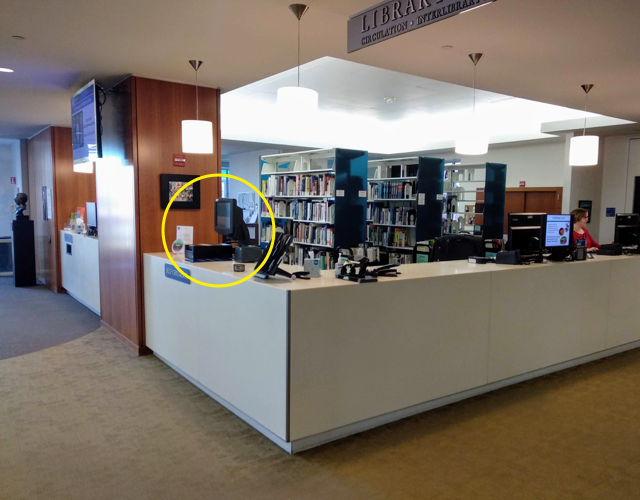
As soon as Rajesh thinks of checking out the items, the “Library Checkout” script gets activated in his long-term memory and the script includes going to the front desk, greeting the library assistant, handing over the items and collecting them. However, he notices that the checkout section is not manned by a library assistant.
Negative. Rajesh is confused about the next step because his script does not include this situation. He is anxious to find an alternative. The self-checkout system is not placed close to the traditional checkout process (Fig 1), so it is not obvious to Rajesh to go to the self-checkout system. Thus, consider keeping the traditional process and the self-checkout process beside each other to help borrowers identify the alternative.
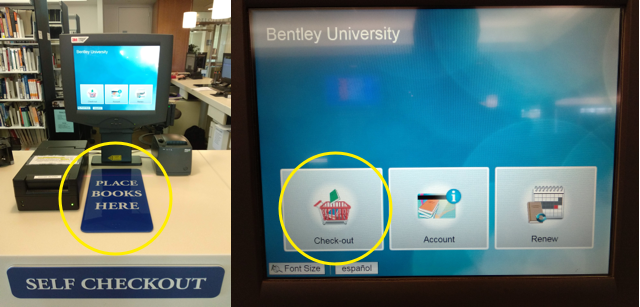
Positive. Rajesh identifies the self-checkout system (Fig 2a) to be similar to a computer because of its components and also an ATM machine because of the touch-screen monitor. Thus, their respective schemas are instantiated. Rajesh identifies the checkout cart symbol in the default screen (Fig 2b) as a metaphor similar to that of an e-commerce website and clicks it. Furthermore, he keeps the two books that he wants to borrow on the blue mat in front of the monitor because he identifies the textual metaphor “Place Books Here” (Fig 2a).
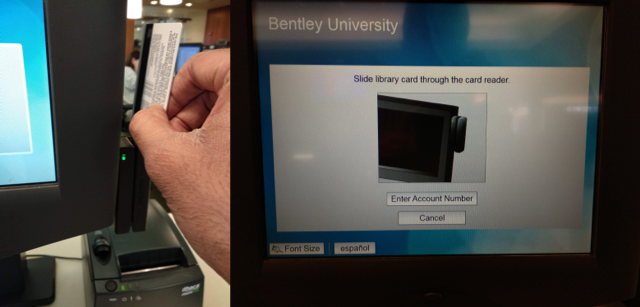
Positive. The system asks him to swipe his library card and he relates this to his mental model of using an ATM (Fig 3a). In the next step, he is asked to enter the last 4 digits of his Bentley ID and he relates it to entering a PIN in the ATM.
Negative. However, the card can be successfully scanned only if the magnetic strip of the card is swiped facing away from the monitor. This is not obvious to Rajesh and he figures it out by trial and error (Fig 3b). Some type of metaphor can be included in this step to prevent user errors or the system should be able to handle both types of swipes.
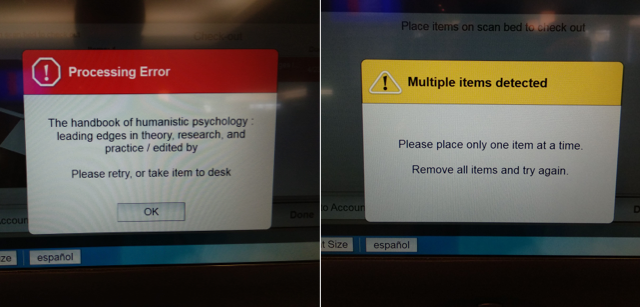
Negative. He receives a warning “Multiple items detected” because he has placed two books on the blue mat (Fig 4a). The textual metaphor on the blue mat said, “Place Books Here”, thus he kept both of his books on the mat. On the other hand, the system can scan only one book at a time. Now Rajesh is getting anxious because he had followed the instructions mentioned by the system and yet encountered a problem. Thus, it is better if the textual metaphor on the blue mat is corrected. Furthermore, when he removed a book from the mat, he received another processing error (Fig 4b). He is very confused at this point and loses confidence in himself, so he chooses to start all over again with only one book on the mat.
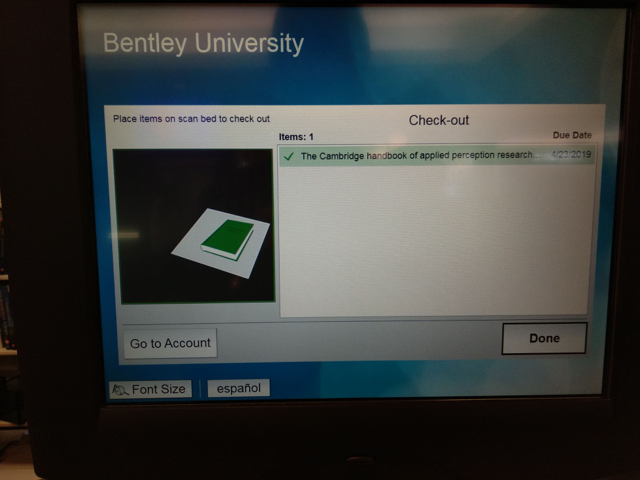
Rajesh’s long-term memory assimilated the information from the first try and accommodated the new learnings to it. In the second try, he follows the updated process and reaches the checkout screen (Fig 5). He realizes that he is yet to check out the DVD and he looks for cues to help him out. He uses his mental model of computer to realize that DVDs are inserted to DVD readers and tries finding something similar.
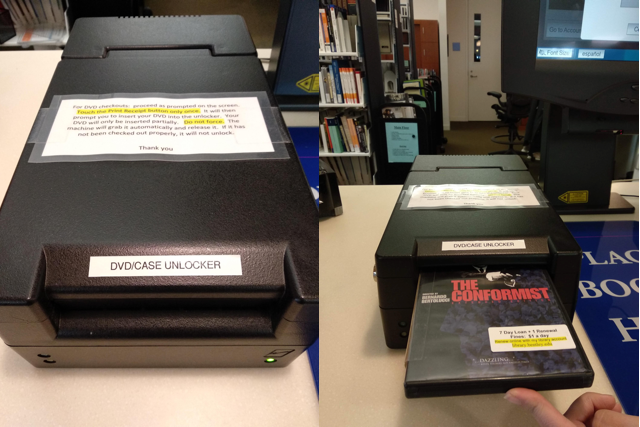

He finds a similar machine placed beside the system and it has a slot (Fig 6a). With the mental model of a computer guiding him and the textual metaphor written on the machine “DVD/CASE UNLOCKER”, he considers the analogy of reading a DVD in a computer and perceives the affordance of the machine to accept the DVD case. However, he realizes that the machine is not working as anticipated because it is not allowing him to insert the DVD case. In this case, he has a confirmation bias that he is interacting with this machine in the correct manner and forcibly pushes the DVD case into the machine (Fig 6b) and receives the error shown in Fig 7.
Negative. The checkout procedure for a DVD included placing the DVD on the blue mat (Fig 8a), the system would then identify the item as a DVD and ask the user to slide it into the machine (Fig 8b), sliding the DVD will unlock the DVD case (Fig 9 a,b). However, the first step which is very crucial and was not obvious to Rajesh because the blue mat had the textual Metaphor “PLACE BOOKS HERE” and his mental model accommodated the information accordingly. Appropriate support has to be provided to ensure either the users are given appropriate cues regarding the process or the system handles other use cases.
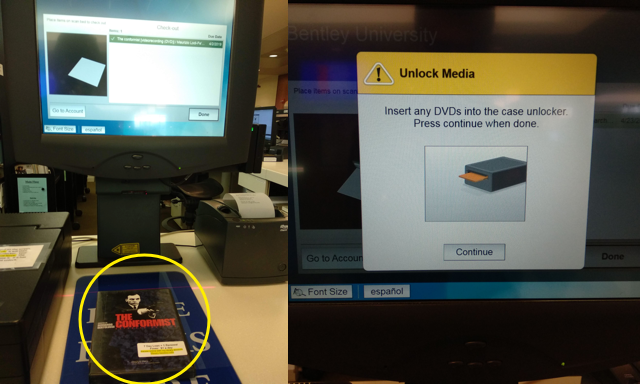

Positive. The final screen of the check-out process includes a screen for a transaction receipt which Rajesh can relate back to the mental model of an ATM. Furthermore, the metaphors used in the screen can be easily understood printer icon for printing, @ icon from email, and block icon for no receipt.
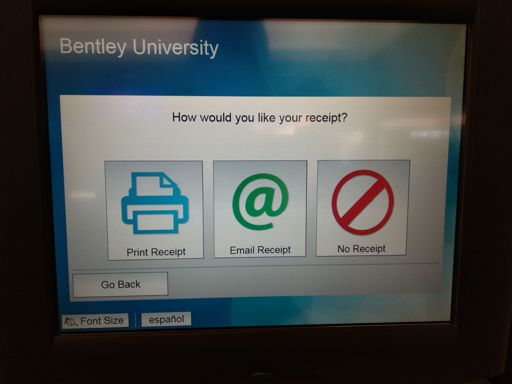
The difficulties mentioned in the library self-checkout process lead users to confusion and anxiousness when the product does not behave as anticipated by the users’ prior knowledge or doesn’t provide enough cues to guide the users. Thus, when people know a less stressful alternative, even though it is confusing, they choose the older alternative to reduce cognitive load from a newer system. As in the case of the aforementioned product review, designers may not take into the influence of prior knowledge on the interactions of a user. Thus, knowledge of information storage and retrieval can enable designers to build a product that can provide a memorable experience to end users.
References
Anderson, J., & Bower, G. (1973). Haman associative memory. Washington, DC: Winston.
Anderson, J. R. (1996). ACT: A simple theory of complex cognition. American Psychologist, 51(4), 355–365. https://doi.org/10.1037/0003-066X.51.4.355
Arbib, M. A. (1992). Schema theory. The Encyclopedia of Artificial Intelligence, 2, 1427–1443.
Atkinson, R. W., Shijfrin, and, & Richard, M. (1968). Human memory ; A proposed system and its control processes. https://doi.org/10.1016/S0079-7421(08)60422-3
Baddeley, A. D., & Hitch, G. (1974). Working Memory. In G. H. Bower (Ed.), Psychology of Learning and Motivation (Vol. 8, pp. 47–89). https://doi.org/10.1016/S0079-7421(08)60452-1
Bartlett, F. C. (1932). Remembering: An experimental and social study. Cambridge: Cambridge University.
Carroll, J. M., & Mack, R. L. (1985). Metaphor, computing systems, and active learning. International Journal of Man-Machine Studies, 22(1), 39–57. https://doi.org/10.1016/S0020-7373(85)80076-6
Chang, T. M. (1986). Semantic memory: Facts and models. Psychological Bulletin, 99(2), 199–220. https://doi.org/10.1037/0033-2909.99.2.199
Collins, A. M., & Loftus, E. F. (1975). A spreading-activation theory of semantic processing. Psychological Review, 82(6), 407–428. https://doi.org/10.1037/0033-295X.82.6.407
Collins, A. M., & Quillian, M. R. (1969). Retrieval time from semantic memory. Journal of Verbal Learning and Verbal Behavior, 8(2), 240–247. https://doi.org/10.1016/S0022-5371(69)80069-1
Craik, S. S. F. I. M. (2006). Lifespan Cognition: Mechanisms of Change. Oxford University Press.
Crowder, J. A., Taylor, J. M., & Raskin, V. (2012). Autonomous creation and detection of procedural memory scripts. Proceedings on the International Conference on Artificial Intelligence (ICAI), 1. The Steering Committee of The World Congress in Computer Science, Computer ….
DiMaggio, P. (1997). Culture and Cognition. Annual Review of Sociology, 23(1), 263–287. https://doi.org/10.1146/annurev.soc.23.1.263
Gazzaniga, M., & Ivry, R. B. (2013). Cognitive Neuroscience: The Biology of the Mind: Fourth International Student Edition. WW Norton.
Gentner, D. (1983). Structure-mapping: A theoretical framework for analogy. Cognitive Science, 7(2), 155–170. https://doi.org/10.1016/S0364-0213(83)80009-3
Gibson, J. J. (1979). The Ecological Approach to Visual Perception. 347.
Johnson-Laird, P. N. (1989). Mental models. In Foundations of cognitive science (pp. 469–499). Cambridge, MA, US: The MIT Press.
Kuipers, B. J. (1975). A FRAME FOR FRAMES: Representing Knowledge for Recognition. In D. G. Bobrow & A. Collins (Eds.), Representation and Understanding (pp. 151–184). https://doi.org/10.1016/B978-0-12-108550-6.50011-2
Minsky, M. (1974). A framework for representing knowledge.
Moray, N. (1999). Mental models in theory and practice. Attention and Performance XVII: Cognitive Regulation of Performance: Interaction of Theory and Application, 223–258.
Nadel, L., & Hardt, O. (2011). Update on Memory Systems and Processes. Neuropsychopharmacology, 36(1), 251–273. https://doi.org/10.1038/npp.2010.169
Norman, D. A. (1999). Affordance, conventions, and design. Interactions, 6(3), 38–43.
Piaget, J. (2014). Studies in Reflecting Abstraction. https://doi.org/10.4324/9781315800509
Quillian, M. R. (1968). Semantic Memory. Semantic Information Processing. M. Minsky. MIT press.
Reder, L. M. (2014). Implicit Memory and Metacognition. Psychology Press.
Rumelhart, D. E., & Norman, D. A. (1976). Accretion, Tuning and Restructuring: Three Modes of Learning: https://doi.org/10.21236/ADA030406
Schank, R. C., & Abelson, R. P. (1975). Scripts, plans, and knowledge. IJCAI, 151–157.
Staggers, N., & Norcio, A. F. (1993). Mental models: concepts for human-computer interaction research. International Journal of Man-Machine Studies, 38(4), 587–605. https://doi.org/10.1006/imms.1993.1028
Taber, C. S., & Lodge, M. (2006). Motivated Skepticism in the Evaluation of Political Beliefs. American Journal of Political Science, 50(3), 755–769. https://doi.org/10.1111/j.1540-5907.2006.00214.x
Taylor, S. E. (1981). Schematic bases of social information processing. Social Cognition, 89–134.
Tulving, E. (1972). Episodic and semantic memory. Organization of Memory, 1, 381–403.
